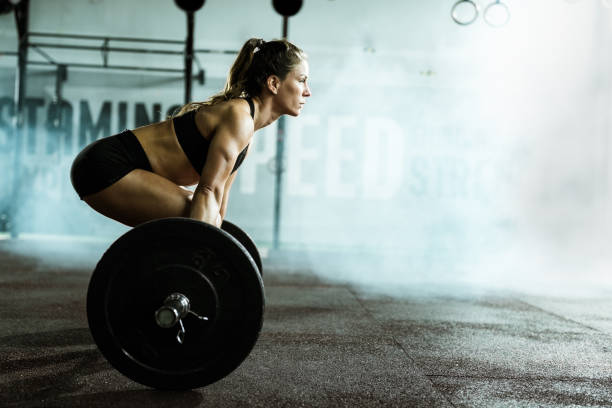The Deadlift is a simple exercise. Pick up a heavy bar off the ground then put it down again. It is one of the most effective exercises for improving total-body strength and athletic performance. The Deadlift is a pulling exercise based on the hip hinge movement pattern. It has many benefits including developing glute, hamstring, back and grip strength.
The Deadlift makes athletes better force producers, as stronger glutes and hamstrings allow more force . Almost all fundamental sports skills, like running, jumping, throwing and tackling start with power into the ground. The more force put into the ground, the more explosively the sport can be played. It also teaches the large hip muscle groups to fire in a coordinated fashion.
Step-by-Step Instructions
The Deadlift is a simple lift, but it’s one of the most butchered and feared exercises performed in the weight room. The most common Deadlift technique failure is a rounding of the back. The lumbar spine, or lower back, is designed for stability, not mobility . When the lower spine rounds, it’s in a compromised position. Coupled with the heavy weight loads typically used in the Deadlift, can cause back injuries. The upper back often rounds as well. Since the upper back can handle some movement, this doesn’t present as big a problem as lower-back rounding. However, it often causes a cascade effect that results in rounding of the lower back.
Step 1: The Approach
Approach the bar and stand with feet about hip-width apart. The bar should be over the midfoot or even touching the shins. Take a big breath to fill the stomach with air. Tighten the core all the way around the body.
Step 2: Grab the Bar
Bend at the waist and slightly at the knees to reach straight down. Grab the bar with both hands, using either a double-overhand or alternating grip. The arms should be completely straight.
Step 3: Start Position
Flatten the back and pull the shoulders toward the back pockets. Pull up on the bar to take the slack out, pull the chest up and sit the hips down so the back is at a slight downward angle—the exact amount of which depends on the individual anatomy. Focus the eyes about 2-3m in front . Lots of tension should be felt in this position. The lats are squeezing, core is tight, and there’s a slight stretch through the hamstrings.
Step 4: The Pull
Pull the bar straight up keeping it as close to the shins as possible, using the glutes and hamstrings to straighten the hips. As the bar travels upward past the knees, begin to pull the bar into the hips. The goal throughout is to keep the bar as close to the body as possible to maximize strength. Continue straightening the hips and knees until standing fully upright. Squeeze the glutes at the top of the rep.
Step 5: Lower the Bar to the Ground
Slowly bend at the waist and keep the bar close to the thighs to begin lowering the bar. Continue hinging at the hips until the bar is below the knees, then bend the knees to finish lowering it to the ground. Do this slowly when first learning the Deadlift but pick up the speed once comfortable with the exercise.
Step 6: Prepare for the Next Rep
If doing more than one rep, there are two options. One, take a deep breath in and go right into the next rep. Or two, reset the start position . Option two is usually preferred when going for heavy reps.

Muscles Trained
Prime movers
- Gluteus maximus, medius & minimus
- Hamstrings: Biceps femoris, semitendinosus, semimembranous
- Quadriceps: Vastus lateralis, vastus intermedius, vastus medialis, rectus femoris
Synergist muscles
- Abdominals, erector spinae, quadratus lumborum, latissimus dorsi, trapezius, rhomboids, adductors, gastrocnemius, brachioradialis

Common Errors
- The Bar Isn’t Directly Under The Shoulders. The bar should be over the shoelaces or even touching the shins, and the shoulders should be straight over the bar. This creates the optimal power position to keep the back flat and to get the glutes and hamstrings involved in the movement.
- The Lats Aren’t Engaged. If the upper back is not engaged, the shoulders will pull forward the second the bar is lifted off the ground, causing rounding. The lats provide the strength and stability to keep the spine from moving. To engage the lats, pull the shoulders down and back. Imagine having a tennis ball under each armpit and try to squeeze the balls as hard as possible.
- Core Isn’t Truly Tightened. To keep the lower spine from bending, the core needs to be tight. If the core is not tight, the spine will be forced to handle the load instead of supporting muscles around it. Take a deep breath in and tighten the abs, obliques and lower back muscles around this air to create an artificial weight belt .
- Not Creating Pre-Lift Tension. To lift with perfect form, tension is needed to engage the muscles. Without tension, there’s a greater chance the muscles won’t do their intended job. Creating tension means taking the slack out of the bar, which involves setting up for the exercise and lifting up against the bar without actually picking the weight off the ground.
- Hips Rise Before The Head. As the lift begins, the butt might come up first, usually because the client is driving with the knees and not extending the hips.
- Overemphasize the Lockout . Some lifters hyperextend their backs in search of the ultimate lockout. All this does is put unnecessary stress on the lower back. The movement finishes when standing straight up.

Variations
There are many Deadlift Variations:
- Conventional Deadlift. This is the standard exercise as described above , standing with feet hip-width apart. It involves a bit more of the lower back than the other variations, but that doesn’t necessarily make it a bad option. Generally, this is the preferred variation.
- Sumo Deadlift . The Sumo Deadlift requires a wide stance. This places the feet wider —still angled out slightly— usually around the rings of the barbell, but ultimately depends on the lifters height. To find the optimal stance, test a few foot positions and stick with the one that allows the lifter to reach down to the bar and maintain vertical shins. The sumo stance shifts the work a bit more to the hips and hamstrings and away from the lower back. It also results in a reduced range of motion.
- Romanian Deadlift.
- Single Leg Deadlift.
- Trap Bar Deadlift.
Check out these other resistance training exercises:
